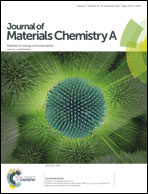Effective strategies for improving the electrochemical properties of highly porous Si foam anodes in lithium-ion batteries†
Abstract
We describe effective strategies to enhance the electrochemical performance of highly porous silicon anodes using a well-known magnesiothermic reduction method. Highly porous silica is synthesized by combining a triblock copolymer template and a silicon precursor. Subsequent magnesiothermic reduction of the porous silica leads to the conversion of silica to silicon particles without a significant change of the original silica structure. In addition, we employ sodium chloride as a heat scavenger to reduce an exothermic reaction that occurs during the magnesiothermic reaction of silica. Since the fusion of sodium chloride absorbs the exothermal heat, the as-synthesized porous silicon can remain as the original silica structure without aggregation. The final strategy is to improve the electrical conductivity of Si particles by introducing metal particles during the magnesiothermic reaction, resulting in a significant improvement of electrochemical performance including a cycling retention and initial coulombic efficiency. These approaches may be extended to ameliorate other anode materials for practical lithium-ion battery applications.


 Please wait while we load your content...
Please wait while we load your content...